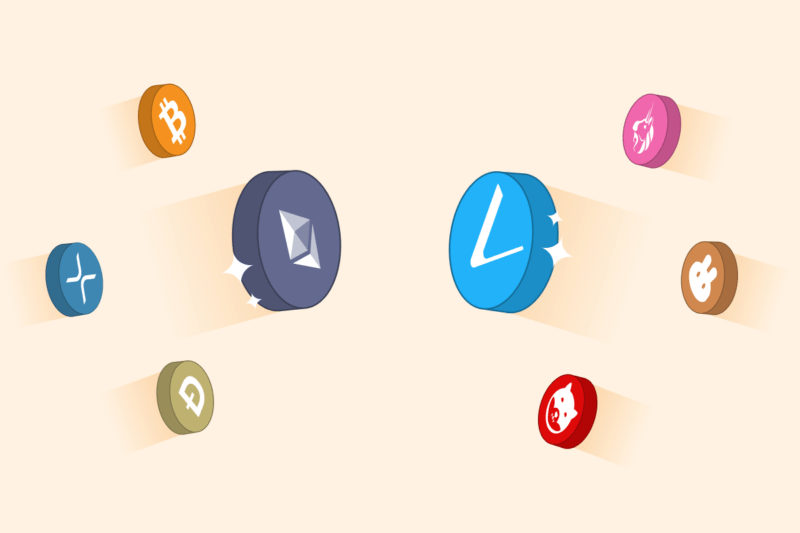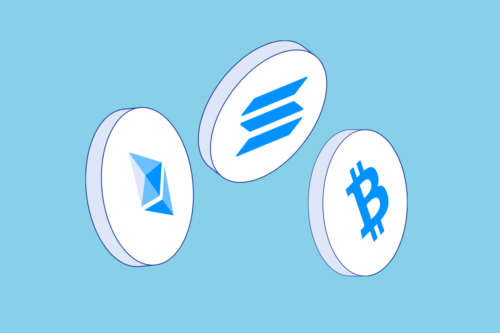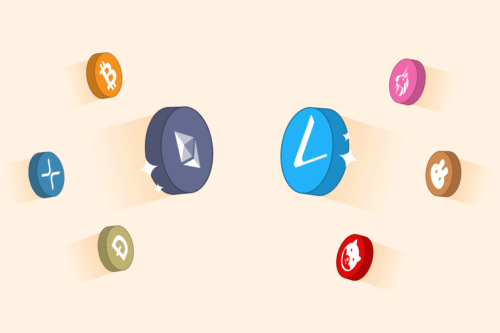
Coins and tokens aren’t just words that belong in the games arcade. They are important terms in the crypto world as well. While the terms “cryptocurrency coin” and “crypto token” are often used interchangeably, these two types of digital assets differ in a number of ways. This article explores the difference between coins and tokens, explains what they are used for, and gives examples of each.
Defining digital assets
A digital asset is anything that exists in a digital form that comes with the right to use. For example, documents, albums, photographs, and movies can all be considered digital assets. For our purposes though, a digital asset is a cryptocurrency: a coin or token that has digital ownership and the right to use attached.
Broadly speaking, digital assets are intangible assets. They are created, traded, and stored digitally. In the case of cryptocurrency, these digital assets utilise the technology behind cryptocurrency, which is called blockchain technology.
What are cryptocurrency coins?
Cryptocurrency coins are native to their own blockchain network. Like fiat currency, they can be used in exchange for goods and services. More specifically, cryptocurrency coins can be used not only as a store of value but to transfer money, and as a medium of exchange. Items can be priced in Bitcoin or other cryptocurrencies.
What is the purpose of coins?
The blockchain protocol on which a specific cryptocurrency runs issues its own coins. This is why they are often referred to as native currency. These coins are created through a process called mining.
Examples of crypto coins
The most well-known cryptocurrency coin is Bitcoin (BTC), but it’s far from the only example. There are currently over 20,000 cryptocurrencies on the market!
These alternatives to Bitcoin are known as altcoins, and while many are derived from Bitcoin’s open-source protocol, several have created their own protocols, such as Ripple (XRP), Litecoin (LTC), and Cardano (ADA).
Another notable example is Ethereum. Although its native currency Ether (ETH) is a coin, many of the top tokens are built on top of the Ethereum blockchain. We will cover this in more detail below.
Key Takeaway
Cryptocurrency coins are native to their own blockchain. Coins are generated through mining, and can be used to pay for goods and services or as a store of value. Some popular examples are Bitcoin (BTC), Ripple (XRP), Litecoin (LTC), and Ether (ETH).
What are crypto tokens?
Tokens still utilise blockchain technology, but unlike coins, they are not native to that blockchain. Tokens are built on top of other blockchains such as Ethereum.
What is the purpose of tokens?
Blockchain tokens are developed by blockchain-based organisations, using existing blockchain networks. The most common network is Ethereum, because of the establishment of smart contracts. Any tokens built on this platform are referred to as ERC tokens.
Developers pay in the native cryptocurrency of a blockchain to create new tokens. Once these have been created, these developers can decide the total units to create and where they will send these tokens.
Often, tokens are created for initial coin offerings (ICOs). Think of these like initial public offerings (IPOs) for stock investors, but instead of shares you’re getting tokens. This is a particularly popular form of fundraising for blockchain-based businesses.
How do tokens function?
Most tokens are created for use in dApps, or decentralized applications. Tokens work within the dApp to unlock or activate certain features or functionalities.
One such example is Basic Attention Token (BAT). This blockchain-based digital advertising platform utilises BAT to reward users for their attention and also provides advertisers with an improved return on their ad spend.
Unlike coins, crypto tokens can not be used to purchase goods and services outside of the dApp they’re created to function with. They can however be traded through exchanges, and like cryptocurrencies, their value may rise or fall over time.
Types of cryptocurrency tokens
There are various categories for cryptocurrency tokens and they all exist for different purposes. Some of the common types of crypto tokens include:
- Security tokens are essentially digital contracts that work as proof of investment for real-world assets like real-estate or corporate stocks
- Utility tokens are issued to fund the development of a particular product or service and are designed to provide access to that product or service
- Non-fungible tokens (NFTs) are digital assets that represent real-world objects or assets like music, art and videos
- Governance tokens are digital currencies that represent voting power on a blockchain-based project
- Rewards tokens are given out as appreciation for providing a service on a blockchain-based platform.
Examples of cryptocurrency tokens
Like coins, thousands of crypto tokens exist. Some of the biggest tokens by market capitalization are Tether (USDT), Binance Coin (BNB), and VeChain (VET).
A goal of many dApps is to provide a solution to issues both in the crypto space and the real world. Some examples of this in action include:
- Bancor (BNT) allows users to create their own cryptocurrencies
- Civic (CVC) offers instant and secure ID verification
- Status (SNT) is a decentralised messaging app similar to China’s WeChat
- Augur (REP) allows anyone to create their own predictions on different markets
- Uniswap (UNI) allows people to exchange and swap ERC-20 tokens.
Key Takeaway
Cryptocurrency tokens are built upon existing blockchain networks, such as Ethereum. Generally tokens are issued rather than mined, and they can be used for a number of different purposes such as proving ownership of a digital asset or enabling voting on a blockchain network. A few popular tokens are Tether (USDT), VeChain (VET), and Binance Coin (BNB).
How to get coins and tokens
Most exchanges list both coins and tokens on their trading platforms. That is the easiest way to buy coins and tokens. Another way is to purchase during an ICO.
There’s no answer as to whether investing in coins or tokens is better, but an understanding of the functions of each should help you make a more informed decision when building out your digital portfolio.
Summary
The cryptocurrency market provides access to over 20,000 coins and tokens, which offer a broad range of exciting and innovative use cases. Cryptocurrency coins are native to their own blockchain whereas crypto tokens are built upon existing blockchains like Ethereum. This article has explored the difference between coins and tokens and explained what they are used for.
If you would like to learn more about blockchain technology, the different types of crypto tokens, or anything else crypto-related, keep exploring Swyftx Learn for plenty more great resources.
Quiz
Disclaimer: The information on Swyftx Learn is for general educational purposes only and should not be taken as investment advice, personal recommendation, or an offer of, or solicitation to, buy or sell any assets. It has been prepared without regard to any particular investment objectives or financial situation and does not purport to cover any legal or regulatory requirements. Customers are encouraged to do their own independent research and seek professional advice. Swyftx makes no representation and assumes no liability as to the accuracy or completeness of the content. Any references to past performance are not, and should not be taken as a reliable indicator of future results. Make sure you understand the risks involved in trading before committing any capital. Never risk more than you are prepared to lose. Consider our Terms of Use and Risk Disclosure Statement for more details.


 Article read
Article read



